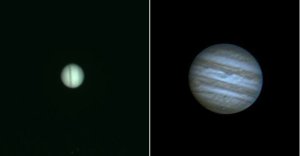

When it comes to doing astrophotography, there are only three ways that you can go about doing it right. First, we can go back to the old days of film, which is not used much these days by photographers of any sort. Second, digital cameras can be used, such as a Digital Single Lens Reflex (DSLR), a standard point and shoot digital camera, or even a Charged Coupled Device (CCD) for low noise long exposure astrophotography. Third, and most importantly, a webcam can be used.
Strictly speaking, a webcam is a digital camera. So in reality, we could say that there are only two ways of doing astrophotography. However, at the moment, I’m trying to differentiate between two separate *types* of digital imaging: long exposure and incredibly short exposure.
There are some major benefits to using a little webcam over that of a large format cooled CCD imager. For one thing, there is the cost! A half decent webcam for astrophotography can cost as little as $100. However, this isn’t the standard run of the mill webcam that you’ll find at your local electrical retailer. For astrophotography, it needs to be slightly modified. For starters, it needs to have a 1.25″ adapter on the front of it, the same fitting that you’ll find on every amateur telescope. This allows you to directly attach the camera to the telescope, as opposed to needing to hold it against the lens, which can be very difficult.
Webcams have a completely different use in astrophotography than a CCD imager does. CCD imagers are generally used for taking long exposure images, but they do have the capability of taking very short exposures as well. When taking images of planets, the Sun, or the Moon a CCD imager becomes less useful. Although a CCD imager is able to take a very short exposure, the objects I just listed are quite bright and don’t need a long exposure. And, although you can generally assume that a $45,000 cooled 16MP CCD imager (that is able to take very short and long exposures) would ultimately be better than a $100 640×480 pixel webcam for taking images of planets, this isn’t always the case.
There are two important reasons for this. First, for the average telescope that an amateur astronomer is going to own, the focal length of the telescope is going to be short enough that we’re going to require a 2x or 4x barlow lens to make a planet take up the entire image frame. Even with the longer focal length of a larger SCT, a planet won’t become larger than the webcam screen without using a barlow. If it just fits inside of a webcam screen, just imagine how much wasted space there is on the large format imager!
This brings us to the second point, how many images can be taken. With a webcam, a movie is taken. Sepending on the setup and the quality of the webcam, anywhere between a dozen and a hundred pictures can be captured every second! That’s a lot of images! What about with the proper CCD imager? Well, it’s going to be taking 16MP images where 15MP of the images are just going to be black wasted space. Although that wasted space can easily be removed later on, it severely limits the speed at which the imager can take successive shots. Remember, each image not only has to be taken but it has to be downloaded onto the computer. 640×480 pixel image is very small, 4096×4096 pixel image… Well… Not so much.

This gets us to the point of why we need so many images. Take a look at these two images. Which do you think is better?
The image on the left was taken with my DSLR (not a webcam) and then HEAVILY cropped. As an image it’s not half bad, the bands of Jupiter are clearly visible, but the image is lacking any detail within the clouds. The reason there isn’t any detail goes further than the camera resolution (although it does play a part, I don’t think I used my 4x barlow when taking this image). For example, turbulence within the atmosphere makes it impossible to take a crystal clear single shot image. As the photons travel through our atmosphere, they pass through thermal currents and get slightly bent and refracted, all of these aspects make it more difficult to get a clear image. Combining many hundreds or even thousands of images works to cancel out this problem. The simple fact is, a large format CCD imager will never be able to take enough images in the short period of time before Jupiter’s rotation becomes visible and blurs the image so as to take a really good planetary photo. And even if it could, you’d need a dedicated external hard drive just to hold the images for processing!
Webcams are the only way to go for planetary astrophotography. Yes, you can get fairly decent single shot images through a large format camera (the DSLR I used is a full frame CMOS sensor) but in the end a $100 webcam will do a better job 🙂
For Further Information: